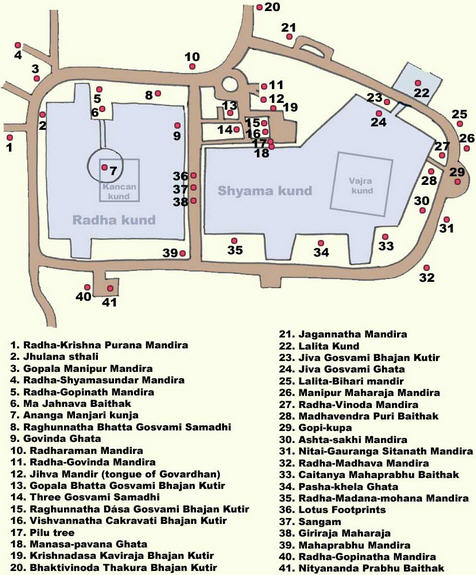
This is a very tranquil and peaceful place. It is considered by Gaudiya Vaishnavas to be the most holy place in the Braja area. It is a very important place to visit. There are two holy tanks here, right next to each other. The town here is also known as Aristavan. In this village, the demon Aristasura was killed by Krishna. Radha Kunda is 26 km (16 miles) west of Mathura. For years Radha Kunda and Syama Kunda
were lost and no one knew exactly where they were located. When Sri Caitanya Mahaprabhu came to Vrindavana in 1514, He rediscovered these two important kundas. Part of the parikrama of Govardhana Hill is going around Radha and Syama Kunda. Radharani and Krishna have their midday pastimes at Radha Kunda.
When Raghunatha Dasa Gosvami first stayed at Radha Kunda, Radha Kunda and Syama Kunda were only 12 feet by 12 feet in size. At that time one rich man named Sampanna went to Badrinath to offer Lord Narayana a large donation. In a dream, Lord Krishna told him to go to Radha Kunda and give the money to Raghunatha Dasa Gosvami to renovate the kundas, which he did. Raghunatha Dasa Gosvami and Jiva Gosvami supervised the expansion of the kundas around 1554.
In the center of Radha Kunda is a small walled-in area called Kancana Kunda. This kunda is said to mark the location of the original kunda that Srimati Radharani and the gopis dug with their bangles. It is said that Vajranabha built a bathing tank at Syama Kunda to commemorate the place where Krishna killed Aristasura. When there is water in Syama Kunda this kunda cannot be seen. When Syama Kunda is empty, you can see a wall encircling a small deep kunda in the center of Syama Kunda. This kunda is called Vajranatha Kunda. Syama Kunda is also known as Arista Kunda. In the eight directions surrounding Radha Kunda are the kunjas (garden groves) of Sri Radha's asta-sakhis (eight main gopis). They are the kunjas of Lalita Devi, Vishakha Devi, Citra Devi, Indulekha Devi, Campakalata Devi, Ranga Devi, Tungavidya Devi, and Sudevi. Sri Ananga Manjari's kunja is in the center of Radha Kunda.
Radha Kunda appeared at 12 midnight on Bahulasthami, the eighth day (asthami) of the waning moon, in the month of Kartika (Oct-Nov). On that day, thousands of people come and bathe at 12 midnight in Radha Kunda. It is an ecstatic and exciting event.
"Mathura is superior to Vaikuntha because Lord Krishna appeared there. Vrindavana is superior to Mathura because Krishna performed His rasa-lila there. Govardhana Hill is superior to Vrindavana because Krishna lifted it and enacted many blissful pastimes there. But the superexcellent Radha Kunda stands supreme above all for it is overflowing with the ambrosial nectarean Prema of Radha and Krishna. (Sri Upadesamrita, verse 9)
"Great sages say that Radha Kunda is as dear to Krishna as Radha Herself. Indeed, Krishna's love for Radha Kunda and Srimati Radharani is the same in all respects." (Sri Upadesamrita verse 11 purport)
In the Adi Varaha Purana it is said that by bathing in Radha Kunda the sin of killing a cow, man or a brahmana is immediately removed. According to the Adi Varaha Purana, by bathing in Radha Kunda and Shyama Kunda one attains the result of performing a rajasuya and asvamedha yajna.
Apperance of Radha Kunda
Killing of Aristasura
"One demon named Aristasura entered the village like a great bull with a gigantic body and horns, digging up the earth with his hoofs. When the demon entered Vrindavana, it appeared that the whole land trembled, as if there were an earthquake. He roared fiercely and after digging up the earth on the river-side, he entered the village proper. The fearful roaring of the bull was so piercing that some of the pregnant cows and women had miscarriages. Its body was so big, stout and strong that a cloud hovered over its body just as clouds hover over mountains. Aristasura entered Vrindavana with such a fearful appearance that just on seeing this great demon, all the men and women were afflicted with great fear, and the cows and other animals fled the village.
"The situation became very terrible, and all the inhabitants of Vrindavana began to cry, `Krishna! Krishna, please save us!' Krishna also saw that the cows were running away, and He immediately replied, `Don't be afraid. Don't be afraid.' He then appeared before Aristasura and said, `You are the lowest of living entities. Why are you frightening the inhabitants of Gokula? What will you gain by this action? If you have come to challenge My authority, then I am prepared to fight you.' In this way, Krishna challenged the demon, and the demon became very angry by the words of Krishna. Krishna stood before the bull, resting His hand on the shoulder of a friend. The bull began to proceed towards Krishna in anger. Digging the earth with his hoofs, Aristasura lifted his tail, and it appeared that clouds were hovering about the tail. His eyes were reddish and moving in anger. Pointing his horns at Krishna he began to charge Him just like the thunder bolt of Indra. But Krishna immediately caught his horns and tossed him away, just as a gigantic elephant repels a small inimical elephant. Although the demon appeared to be very tired and although he was perspiring, he took courage and got up. Again he charged Krishna with great force and anger. While rushing towards Krishna, he breathed very heavily. Krishna again caught his horns and immediately threw him on the ground, breaking his horns. Krishna then began to kick his body, just as one squeezes a wet cloth on the ground. Being thus kicked by Krishna, Aristasura rolled over and began to move his legs violently. Bleeding and passing stool and urine, his eyes staring from their sockets, he passed to the kingdom of death." (Krishna Book)
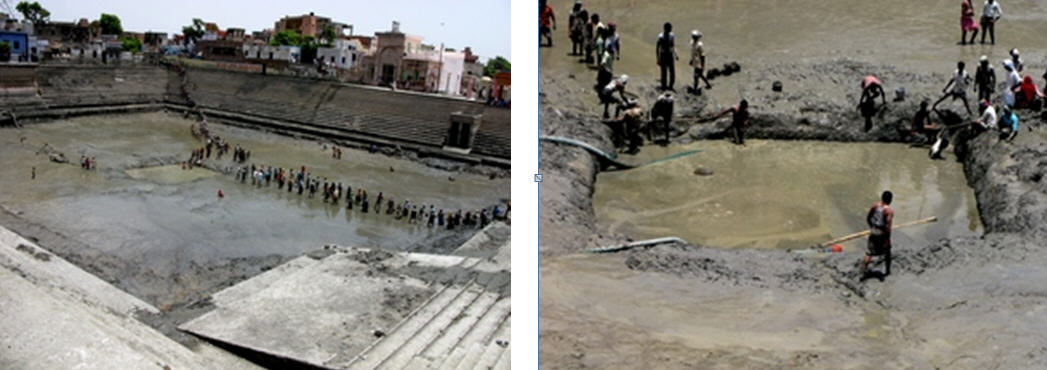
Story of Radha Kunda The story of Radha Kunda is that one demon named Aristasura, in the body of a bull, was killed by Krishna. The gopis (cowherd girls) told Krishna, "that for killing a bull, the symbol of religion, He had to purify Himself by visiting every, single holy place in the three worlds. If you take bath at all the holy places, You will be relieved of the offense of killing him."
Krishna then said, "Why should I visit all these places, I will just bring the water from all these places here and then bathe in them." Krishna then struck His heel on the ground and all the waters of all the holy places entered into Shyama Kunda. Krishna then bathed in Shyama Kunda. He finished his bath sometime before midnight.
After bathing, he said that the gopis had become impure because they had sided with a demon, even though he had been in the form of a bull. The gopis led by Radharani then dug another pond nearby with their bangles. There was no water in the hole, so the gopis formed a line to Manasi Ganga and began to fill the hole they dug by passing water from one gopi to another. Then a representative of all the sacred places told Radharani, "Our lives would be successful if we could enter Your pond." The holy waters from Syama Kunda then flowed into Radha Kunda with the permission of Radha. So Radha Kunda is the holy waters from all the sacred places.
In the center of Radhakunda of today is small area with the wall around it called Kankanakunda (or Kancankunda). It is the area of the original pond created by gopis with their bracelets.
Description of Radha Kunda in the Spiritual World
Radha Kunda is surrounded by kadamba, campaka, asoka, mango, punnaga (white lotus) and bakula trees, and lavanga and vasnati creepers. The banks are decorated with different kinds of gems. Radha and Krishna swing on a gold gem-studded swing, hanging from a tree.
Srila Bhaktivinoda Thakur gives a description of Radha Kunda in his book, Gita Mala. The banks of Radha Kunda are made of desire-fulfilling touchstones. There are hundreds of beautiful transcendental gardens surrounding the lake. The trees and creepers of the gardens are made of coral and rubies and the fruits they produce are pearls and diamonds.
Krishna Dasa Kaviraja in his Sri Govinda-lilamrita and Sri Visvanatha Cakravarti in his Sri Krishna Bhavanamrita describe Radha Kunda in the spiritual world. On the four sides of Radha Kunda are jeweled stairways leading to jeweled bathing ghatas. A jeweled bridge connects Radha Kunda with Shyama Kunda. On either side of the ghatas are pairs of swings. There are jeweled platforms around the stairs of the ghatas, flanking gem-studded cottages.
There are many shade trees and flowering creepers. These flowering creepers have unlimited flowers. On all side of Radha Kunda. are kalpa-viksa (wish-fulfilling) trees. The bathing ghatas are surrounded by various kunjas (forest groves or gardens).
Taking Caution when Bathing at Radha-kunda
One of the most auspicious times for bathing at Radha-kunda is on Bahulashtami, the appearance day of Radha-kunda. Nevertheless, when one bathes in the sacred waters of Radhakunda, one has to be extremely careful not to commit any offences. Radha-kunda is considered to be the liquid form of Radharani; therefore one must observe the proper etiquette in accordance with the Vaishnava scriptures. In the opinion of Srila Prabhupada, only those who are on the same spiritual level as Raghunatha Dasa Goswami, are fit to live at Radhakunda and bathe in Her transcendental waters. Therefore, when bathing there, one must follow in Srila Raghunatha's transcendental footsteps while emulating his mood of humility and servitude.
Bathing at Radha-kunda should be performed as a sacrificial offering to Radharani, with the same reverence as when worshiping the deity of Radha and Krishna in the temple. It is a Gaudiya Vaishnava tradition, that when entering the sacred Radha-kunda to take bath, one should first put one's right hand into the water followed next by ones feet; this is because Vaishnavas do not enter the sacred kunda with feet first. The same etiquette should also apply to Shyama-kunda. There are some Vaishnavas who even crawl on their knees into the kunda out of respect for Radharani. Some Vaishnavas, who are unwilling to enter the sacred kunda, scoop water in a Iota or kamandalu, and pour it over their heads in order to bathe without committing any offence.
In 1936, Srila Bhaktisiddhanta Saraswati, the illustrious founder of the Gaudiya Matha, led a one thousand strong parikrama party on the Vraja Mandala Parikrama. When they arrived at Radha-kunda, out of great reverence for the sacred kunda, they did not take bath, but simply sprinkled three drops of water on their heads, which, according to the Vedas, is equal to bathing, while at the same time showing the utmost respect for Radharani's sacred kunda.
In 1976, Srila Prabhupada heard that a parikrama group of his junior disciples were frivolously joking around on the banks of Radha-kunda and jumping into the sacred lake as if they were at a swimming pool or beach resort. Srila Prabhupada became very upset saying, "There is no difference between Radha-kunda and Radharani, so how can they jump over Radharani? You cannot even touch your feet to Radha-kunda. You can take a little water on your head. This is showing respect to Radha-kunda.'' Srila Prabhupada also said regarding the offensive mentality of some devotees, "Don't go to Radha-kunda simply to become a monkey in your next life". On another occasion years later, a group of western female devotees clad in bikinis were seen jumping and splashing around in Radha-kunda as if they were on the beach at Goa. Such rank neophyte devotees should never go to such a holy places like Radha-kunda in the first place, as they are spiritually unfit due to their offensive behavior and irreverence towards Radharani. Such neophytes cannot reap the benefit of visiting such an exalted holy place; on the contrary, they will simply become degraded due to committing Dhama-aparadha. There is a very famous saying of Srila Bhaktisiddhanta Saraswati, regarding the rank neophyte devotees and sahajiyas who congregate at Radha-kunda, when he once said, "There are many babajis who come to Radha-kunda to live, but because of their grievous offences, they are not actually living at Radhakunda, but at Naraka-kunda (hell)."
Kunjas of Eight Sakhis Radha Kunda is surrounded by the kunjas (garden groves) of the eight main sakhis.
1. Sri Lalita Sakhi's Kunja (north, lighting) is the largest kunja. There are platforms made of gold, sapphires, crystal and lapis lazuli. In the center of a courtyard is a golden temple called Ananga Rangambuja, which is in the shape of a 1,000 petal lotus.
2. Sri Visakha Devi's Kunja (northeast).
3. Sri Citra Devi's Kunja (east, multi-colored) has a wonderful variety of forms and colors. Citra means `variegated or wonderful."
4. Sri Indulekha's Devi's Kunja (southeast, white). Everything is completely white in color, including the trees, thrones, cottages, etc.
5. Sri Campakalata Devi's Kunja (south, gold).
6. Sri Ranga Devi's Kunja (southwest, syama-blue) is Srimati Radharani's favorite, because the dark blue color of everything reminds Her of Krishna.
7. Sri Tungavidya Devi's Kunja (west, crimson). Everything is a crimson color in this kunja and the entire grove is inlaid with rubies.
8. Sri Sudevi Devi's Kunja (northwest, green). Everything is green. It has emerald covered thrones.
9. Sri Ananga Manjari's Kunja is in the center of Radha Kunda. It is connected to the north bank of Radha Kunda by a crystal bridge. The north bank is where Jahnava's Devi's sitting place is located. In the center of this kunja is a jeweled temple. Kunjas of the Eight Sakhas Syama Kunda is surrounded by the kunjas of the eight main sakhas (cowherd boyfriends), called priya-narma sakhas. These boys are Krishna's most intimate cowherd boyfriends and they understand and are submissive to Krishna's dealing with the gopis. The cowherd boys give their kunjas to different sakhis to manage. 1. Subala Kunja (northwest) is on the side of Syama Kunda where Manasa-pavana Ghata is located. It is managed by Radharani. Radharani and the rest of the sakhis bathe daily at 12 noon at Manasa-pavana Ghata. 2. Madhumangala's Kunja (north) is managed by Lalita Devi. 3. Ujjvala's Kunja (northwest) is managed by Visakha Devi. 4. Arjuna's Kunja (east) is managed by Citra Devi. 5. Gandharva's Kunja (southeast) is managed by Indulekha. 6. Vidagdha's Kunja (south) is managed by Campakalata. 7. Kokeela's Kunja (southwest) is managed by Ranga Devi. 8. Sanandananda's Kunja (west) is managed by Tungavidya Devi. Radha Kunda Pratibhu Deities In 1670, many of the original Deities of Vrindavana were moved to Jaipur. Their first stopping place was Radha Kunda. Small replica temples of the original temples in Vrindavana were built at Radha Kunda. Pratibhu-murtis (expanded forms, non-different from the original Deities) were established at Radha Kunda to honor the Lord's visit here, and the worship has been continued for centuries. The residents of Radha Kunda can visit the seven major temples of Vrindavana without leaving Radha Kunda.
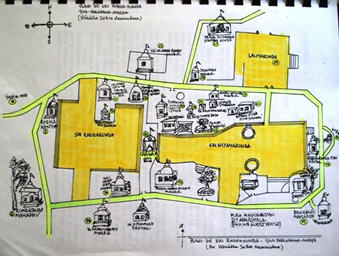
Around Radha Kunda
Radha Gokulananda Temple
From where you arrive by taxi or by bus you walk down the road toward Radha Kunda. Just past the small hospital, on the left, is the Radha Gokulananda Temple. There is a sign above the doorway that says Radha Gokulananda Temple in English, Hindi and Bengali. This temple contains the pratibhu-murtis of Radha Gokulananda. The original Deities are at the Radha Gokulananda Temple in Vrindavana. The puspa samadhis of Lokanatha Gosvami and Narottama Dasa Thakur are next to this temple.
Sri Kundeswara Mahadeva Temple
As you continue walking to Radha Kunda, you come to the small white marble roadside temple of Sri Kundeswara Mahadeva, on the left. This is just before you see Radha Kunda on your right. There are four Lord Siva temples in the four directions, surrounding Radha Kunda, to protect Radha Kunda from intrusion of unqualified persons.
Jhulan Sthali
As you continue on this road, Radha Kunda is on your right. Another 65m (200 feet) from the Sri Kundeswara Mahadeva Temple is a stone structure shaped like an upside down U, on the right side of the path, near Radha Kunda. This marks the site of Radha's and Krishna's swing pastimes.
Radha Krishna Temple and ISKCON Temple
If you walk up the small alley sloping up the hill to your left, near Jhulan Sthali, you come to the blackish pyramid-shaped Radha Krishna Temple, on your left. This temple is the oldest temple at Radha Kunda. Raghunatha Dasa Gosvami rediscovered the Radha-Krishna Deities in this temple when he excavated Radha Kunda. They are said to be the presiding Deities of Radha Kunda. There is a large neem tree and banyan tree en-twined together in the courtyard of this temple, which are wor-shiped as Radha and Krishna.
Next to this temple is a small ISKCON Temple, which has a good view of Radha Kunda from the roof.
Gopala Manipur Mandir and Radha Kanta Temple
You return to the parikrama path, turn left and walk 20m (60 ft) . The next road you see is the Govardhana parikrama path. Just after this junction, on the left, is the red stone Gopala Manipur Mandira. In 1994, Bhakti Swarupa Damodara
Maharaja took possession of this temple. The white building opposite this temple houses the pratibhu Deities of Radha Kanta. The original Deities were worshiped by Sri Vakreswara Pandita in Jagannatha Puri. There is a murti of Vakreswara Pandita on the right side of the altar.
Radha Kunja Bihari Gaudiya Math Temple
Coming out of the Radha Kanta Temple you turn left, walk 7m (20 feet) , and turn right going backwards on the Govardhana parikrama path. After a five minute walk (100 metres) you come to the red stone Radha Kunja Bihari Temple. This temple is on the Govardhana paizkrama path. Located here are the Deities of Radha Kunja-bihari and Caitanya Mahaprabhu.
Next to this temple is the puspa-samadhi of Gaura Kisora Dasa Babaji Maharaja. He lived in Vrindavana for 30 years and was the spiritual master of Srila Bhaktisiddhanta Sarasvati Maharaja. This temple was founded by Srila Bhaktisiddhanta in 1935.
Radha Syamasundara and Radha Damodara Temples
Back at the Radha Kunda parikrama path, just pass the Gopala Mandira, you turn down a small lane on the left. Five metres (15 ft) down this lane, on the left hand side, is the Radha Syamasundara Temple. Syamananda Prabhu's sitting place and puspa-samadhi are here.
Further down this lane (30m, 90 ft), on the left, is the small red-colored Radha Damodara Temple. Across the street from this temple is the sitting place of Srinivasa Acarya.
Gopinatha Temple & Raghunatha Dasa Gosvami's Samadhi
If you go back to the main road and continue down the road 30 seconds, just pass the water taps, you come to the Radha Gopinatha Temple, on the right. This temple is right next to Radha Kunda. On the altar of this temple, the Deity of Gopinatha is in the center, on His right hand side is Srimati Radharani, and on His left hand side is Ananga Manjari, the younger sister of Radharani.
Some of the ashes of Raghunatha Dasa Gosvami are entombed in this temple. There is 24 hour kirtana at this spot. Behind the samadhi, is a small movable stone. Under this stone is charanamrita from Raghunatha Dasa Gosvami's samadhi-murti. You can also get some of Raghunatha Dasa Gosvami's buttermilk mahaprasada, which is kept behind the kirtana party in a small niche in
the wall.
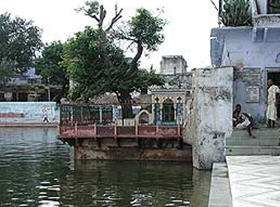
Jahnava Baitaka If you exit out the door to the left of the altar, containing the Deity of Gopinatha, it leads to a small platform jutting out into Radha Kunda. This is where Jahnava Devi (in 1582), the wife of Lord Nityananda, stayed. This spot is known as Jahnava Baitaka, the sitting place of Jahnava. There is a tamal tree and a small shrine here. Next to this place is Jahnava Ghata.
Mahadeva Siva and Radha-Raman Temples You then return to the parikrama path and continue down the path 15m (45 ft). On your left is the red stone Mahadeva Siva Temple. Lord Mahadeva protects the northern side of Radha Kunda.
Right next to this temple is the Radha-Raman Temple. In 1879 the Deities of Sri Radha-Raman and Sri Sri Revati-Balarama were installed in this temple.
Radha Govinda Temple and Tongue of Govardhana Across the street from the Radha-Raman Temple and down a little is the Radha Govinda Temple, on the right. This temple contains the pratibhu Deities of Rupa Gosvami.
In the outer compound of this temple is the Tongue of Govardhana. To get to the tongue of Govardhana you turn left immediately after leaving the Govindaji temple, before you reach the path. You walk up some steps and you come to a small gar-den with a small white temple in it. The temple is known as the Jihva Mandira. Jihva means "tongue."
Raghunatha Dasa Gosvami saw the need of a water source other than Radha Kunda, so he decided to have a well dug. As the workers dug down, they struck a rock and blood flowed from it. That night in a dream it was revealed to Raghunatha Gosvami that the stone was the tongue of Govardhana and should be worshiped.
Teen Samadhis and Krishna Dasa Kaviraja Gosvami's Bhajana Kutir
If you turn to the left after leaving the Radha Govinda Temple, on the path toward Syama Kunda, and walk straight 20m (60 ft) , you then come to the Teen (three) Gosvami Samadhis of Raghunatha Bhatta (left side), Krishna Dasa Kaviraja (center), and Raghunatha Dasa Gosvami (right side). Each of these devotees left this world on the same day, but in different years: Raghunatha Bhatta Gosvami (1563) , Raghunatha Dasa Gosvami (1583) , and Krishna Dasa Kaviraja (1588). Gopal Bhatta Gosvami's bhajana kutir is twenty feet to the right, as you face the Teen Gosvami Samadhis.
To the left of the Teen Samadhis is the bhajana kutir of Krishna Dasa Kaviraja Gosvami. It is set back, about 50 feet, from the side of Shyama Kunda. This is where he wrote the Caitanya Caritamrita.
Gadadhara Caitanya Temple The Gadadhara Caitanya Temple is right next to Krishna Dasa Kaviraja's bhajana kutir. Sachidevi (Ganga mata) and Laksmipriya, the disciples of Haridasa Pandita, did their bhajana where this temple is located. The Deities in this temple are from left to right: Sri Nityananda Prabhu, Lord Caitanya, and Sri Gadadhara.
Haridasa Pandita Gosvami is mentioned in Caitanya Caritamrita. Ganga Mata was a princess. After her father died she ruled the kingdom. After a short time, she renounced the kingdom and came to Vrindavana. She then got initiated by Haridasa Pandita. She then moved to Radha Kunda to join Laksmipriya, who was chanting 300,000 names a day and worshiping the Deities of Gadadhara-Caitanya. Eventually Ganga Mata moved to jagannatha Puri, where she initiated many followers.
Bhajana Kutirs of Raghunatha Dasa Gosvami & Visvanatha Cakravarti The bhajana kutir of Raghunatha Dasa Gosvami is directly opposite Krishna Dasa Kaviraja Gosvami's bhajana kutir. It is down a few steps, toward Shyama Kunda. It is a rectangular building with metal gates. He lived at Radha Kunda for 41 years. At this place Raghunatha Dasa Gosvami would speak three hours a day about the ecstatic pastimes of Lord Caitanya.
There is a painting inside his bhajana kutir, in which he is absorbed in thinking about Krishna, not realizing that there are two tigers near by drinking some water from Shyama Kunda. Nor did he see Krishna standing near him, protecting him. Sri Sanatana Gosvami is standing in the left corner of the painting, observing what is happening. Sanatana Goswami gently rebuked Raghunatha Das Goswami not to take service from Krishna. Another time Raghunatha Das Goswami was absorbed in chanting the holy names of Krishna on the bank of Radha Kunda. The sun was gradually rising up & souring in the sky. The afternoon heat was intense. Sanatana Goswami was passing by & happen to see that Radharani was holding her upper cloth over Raghunatha Goswami to give him shedding from the sun. While doing that she was perspiring. Again Sanatana Goswami gently rebuked Raghunath Das. He requested Raghunatha to build Bhajan Kutir. That was begining of building bhajan kutir in Vrindavana.
On the left side of the same building is the bhajana kutir of Sri Visvanatha Cakravarti Thakura. He lived here about 100 years after Raghunatha Dasa Gosvami. Pandava Trees
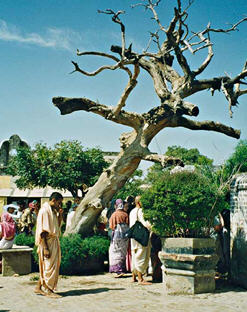
Also near here is where the Pandavas lived as trees on the bank of Shyama Kunda. When Raghunatha Dasa Gosvami was excavating Shyama Kunda, Maharaja Yudhisthira appeared to him in a dream. He told him not to cut the trees besides Shyama Kunda, because he and his brothers, the Pandavas, were living there as trees, meditating on the banks of Shyama Kunda. He therefore dug around the trees, giving Shyama Kunda its irregular shape. Local authorities say the Pandavas have left and only a dead tree marks the place of their previous residence. The place where these trees used to be located is to the left of Raghunatha Dasa Gosvami's bhajana kutir (if you are facing Shyama Kunda), next to Shyama Kunda.
Manas Pavan Ghata
At Manas Pavan Ghata, Radharani and her girlfriends are said to bathe every day at noon. This ghata is close to Raghunatha Dasa Gosvami's bhajana kutir.
Bhajana Kutir of Bhaktivinoda Thakur and Bhaktisiddhanta Sarasvati
Bhaktivinoda Thakura's (1838-1914) house, which was built in the beginning of the century, is located down a side road going away from Shyama Kunda. After leaving the Govinda Temple and turning right back onto the parikrama path, you walk about 25m (75 ft). You then go left onto the broad cobble stone road, when the parikrama path turns right. You then walk 70m (200 ft) and this place is on the right side of the road. It has a colorful sign above the entrance which says: Vraja Swananda Sukhada Kunja. Srila Bhaktivinoda Thakura and Srila Bhaktisiddhanta Sarasvati used this bhajana kutirfrom 1900 to 1936. Bhaktisiddhanta Sarasvati would come here during the month of Kartika (Oct/ Nov). The puspa-samadhis of both Bhaktivinoda Thakur and Bhaktisiddhanta Sarasvati are located here. There are personal articles of Srila Bhaktisiddhanta in this house: his wooden shoes, walking stick, bed, chair, and table. Here at Radha Kunda, Bhaktisiddhanta Sarasvati instructed Srila A C Bhaktivedanta Swami Prabhupada. "If you ever get money, print books.
" If you follow the path that goes to Bhaktivinoda Thakur's bhajana kutir to the edge of the town, there are two bodies of water. Balarama Kunda is on the right side and Vrishabhanu Kunda (Bhanu Khor) is on the left. Vrishabhanu Maharaja (Radharani's father) is said to have had his camp here during the time of Govardhana puja.
Jagannatha Temple
If you proceed back to the parikrama path from Bhaktivinoda's house and make a left, you come to the Jagannatha temple on the left, after about 25m (75 ft). The Deities in this temple are taken around the kunda every year on Rathayatra. Lalita Kunda and Lalita Mohana Temple A little further down, on the left side of the road, is Lalita Kunda. The body of water just past the wall of Lalita Kunda is Mohan Kunda. It is said that Lalita and Mohan (Krishna) called the 68 tirthas (holy places) to come and reside in her kunda. One who bathes in this kunda gets the benefit of becoming free from the sin of six kinds of hatya (murder) : (1) brahma-hatya (killing a brahmana), (2) go-hatya (cow slaughter), (3) bhrina-hatya (abortion), (4) krimi-hatya (killing insects), (5), shvana-hatya (kiiling dog), (6) atma-hatya (suicide).
Next to Lalita Kunda is the Lalita Mohana Temple, where there are Deities of Krishna and Lalita Devi. These Deities are the presiding Deities of this kunja (forest grove). This temple is managed by followers of the Nimbarka sampradaya. To take some water from Lalita Kunda on your head you have go through this temple to reach the kunda. To the left of the altar is a door that leads to Lalita Kunda.
Jiva Gosvami's Bhajana Kutir
Directly across the road from Lalita Kunda is the bhajana kutir of Jiva Gosvami and the small Radha Damodara temple. Jiva Gosvami did much of the practical work of excavating and managing Radha Kunda. Inside the bhajana kutir is the impression of Sri Caitanya Mahaprabhu's footprints.
Radha-Vinoda Temple
Thirty metres down the parikrama path from Lalita Kunda is the Radha-Vinoda Temple, which is a small temple on the right side. In this temple are Radha-Vinoda, the pratibhu Deities of Lokanatha Gosvami.
Gopi Kupa
About 15 metres down the path, on the left, is the well where the tongue of Govardhana was found, called Gopi Kupa. This well is a large circular stone structure. This well is also known as Giriraja jihvaa prakata sthali.
Srila Madhavendra Puri's Baithaka (Sitting Place)
Across the street from Gopa Kupa well, behind a building, is where Madhavendra Puri sat while doing Govardhana parikrama, several years before Lord Caitanya revealed Radha Kunda. To get here you walk down the lane opposite the well and then you enter the gate on your left. There is a small raised shrine on the right of the courtyard. This place is known as Vyasa Ghera.
Radha Madhava Temple
After Madhavendra Puri's sitting place you come to the Asta Sakhi Temple, on the right side of the path. In this temple are small Deities of Radha and Krishna. There are also deities of Lalita, Visakha, Citra, Campakalata, Tungavidya, Indulekha, Rangadevi and Sudevi in this temple. They are the eight main gopis. On the opposite side of the street from this temple is the Nitai-Gaura Sitanatha Temple. The Deities in this temple are from left to right: Nitai (Nityananda), Gaura (Sri Caitanya), and Sitanatha (Advaita Acarya). The next temple to be reached is the Radha Madhava Temple, which is on the left side of the path. Radha Madhava are the pratibhu Deities of Jayadeva Gosvami, the author of Gita Govinda.
Bankhandi Mahadeva Siva Temple
If you continue around the path you come to a water pump on the left. Just before the path bends to the right, 10 metres (30 ft) further,on the left hand side is a small dirt path which leads to the Bankhandi Mahadeva Siva Temple. This Siva Deity protects Radha Kunda on the eastern side.
This temple is on the bank of Narayana Sarovara. It is said that Krishna manifested His four-armed form of Lord Narayana here to play with the gopis.
About a km past Narayana Sarovara is Lagamohan Kunda. It is said that Shankhacuda (Shankhacura) left Radha and the gopis at this place, after Krishna ruined his attempt to kidnap them. This is the place where Krishna killed the demon Shankhacuda. Krishna took the jewel from his head and gave it to Balarama. Balarama then gave the jewel to Radharani. Raghunatha Dasa Gosvami stayed here when he first came to Vrindavana. He was requested by Sanatana Gosvami to move to the bank of Shyama Kunda. Not many people visit Lagamohan Kunda, so it is a peaceful place.
Mahaprabhu's Baithaka (Tamala Tala)
If you continue about 10 metres (30 ft) around Syama Kunda, you come to the place where Lord Caitanya Mahaprabhu sat when He came to Radha Kunda and Syama Kunda. This spot, called Tamala Tala, is on a platform with a tamala tree on it, on the bank of Shyama Kunda. Lord Caitanya's footprints are enshrined here. Mahaprabhu's baithak a means "Mahaprabhu's sitting place." When Lord Caitanya came here, Radha Kunda and Shyama Kunda were small ponds surrounded by forest and fields. All the buildings around Radha Kunda have been built since Lord Caitanya discovered Radha Kunda, almost 500 years ago. Lord Caitanya Discovers Radha Kunda
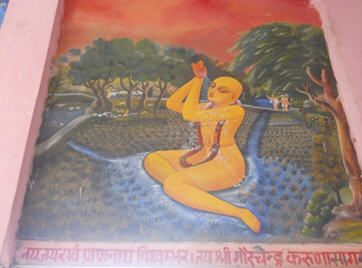
"Sri Caitanya Mahaprabhu asked the local people, `Where is Radha Kunda?' No one could inform Him, and the brahmana accompanying Him did not know either.
"The Lord then understood the holy place called Radha Kunda was no longer visible. However, being the omniscient Supreme Personality of Godhead, He discovered Radha Kunda and Shyama Kunda in two paddy fields. There was only a little water, but He took His bath there.
"When the people of the village saw Sri Caitanya Mahaprabhu taking His bath in those two ponds in the middle of the paddy fields, they were very astonished. The Lord then offered His prayers to Sri Radha Kunda.
"Of all the gopis, Radharani is the dearmost. Similarly the lake known as Radha Kunda is very dear to the Lord because it is very dear to Srimati Radharani.
"Srimati Radharani is most dear to Lord Krishna, and Her lake known as Radha Kunda is also very dear to Him. Of all the gopis, Srimati Radharani is certainly the most beloved. In that lake, Lord Krishna and Srimati Radharani used to sport daily in the water and have a rasa dance on the bank.
"Indeed Lord Krishna gives ecstatic love like that of Srimati Radharani to whoever bathes in that lake even once in his life. The attraction of Radha Kunda is as sweet as that of Srimati Radharani. Similarly, the glories of the kunda are as glorious as Srimati Radharani.
"Because of its wonderful transcendental qualities, Radha Kunda is as dear to Krishna as Srimati Radharani. It was in that lake that the all opulent Lord Sri Krishna performed His pastimes with Srimati Radharani with great pleasure and transcendental bliss. Whoever bathes just once in Radha Kunda attains Srimati Radharani's loving attraction for Sri Krishna. Who within this world can describe the glories and sweetness of Sri Radha Kunda?" (Caitanya Caritamrita Madhya 18.3-14)
Pasa Ghata
About 20m (60 ft) further down the path is the Manoranjan Dharamshala. Directly across the path, is a door that leads to Shyama Kunda. If you go through this door you come to a stone platform jutting out into Shyama Kunda. This place is known as Pasa Ghata, which is where Radha and Krishna are said to play pasha khela (a board game with dice) during their midday pastimes. Govinda Lilamrita says that Radha and Krishna play dice in Sudevi's kunja on the northwest side of Radha Kunda. In this compound is a temple that commemorates Vallabhacarya's stay here. You then return to the parikrara path. About 30 metres down the path, on the left, is the Laksmi Narayana Temple, which is an old temple, about 500 years old.
Madana Mohana Temple
A little distance down the path, on the right, is the Madana Mohana Temple. There is a big archway near the entrance of this temple.
Pathway between Radha Kunda and Shyama Kunda About 5m (15 ft) past the Madana Mohana temple are the stairs that lead to the path where Radha Kunda and Shyama Kunda meet. Near these stairs is a Gaura Nitai temple.
The savant (meeting place) of Radha Kunda and Shyama Kunda is called Ratna-vedi (jeweled platform). There are slits in the stone path between Radha Kunda and Shyama Kunda, that allows mixing of the waters of these two kundas.
On this path, just past the mini-mountain of Govardhana shilas, is a small open air shrine honoring the lotus footprints of Radha Syamasundara, called Sri Carana Cinha. The Banke BihariTemple is an old temple on the right, just beyond Sri Carana Cinha. There are some interesting Govardhana-shilas in this temple.
About five metres (15 ft) further is a neem tree hanging over the path beside Radha Kunda. This area is called Govinda Ghata. This is where Radha and Krishna are said to sometimes enjoy jhulana (swing) pastimes.
Radha Gopinatha Temple, Nityananda Baitaka and Imli Tala
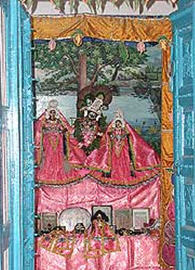
If you come back up the stairs and continue to the right down the path after 30 metres (90 ft) you come to the Radha Gopinatha Temple on the left side, just before the shops. In this temple are the pratibhu Deities of Madhu Pandita's Deities, which are now worshiped in Jaipur.
In this compound, just opposite the temple, is a small building that marks the place where Nityananda Prabhu sat, called Nityananda Baitaka
. By here, in the courtyard of the Braja Mohan temple, is the Imli Tala tree, near which Rupa Gosvami sat. About 20 metres (60 ft) further down the path is a Deity of Hanuman, on the right side, in between some shops. This completes the parikrama of Radha Kunda and Shyama Kunda.

Radha Kunda to Kusuma Sarovara
A few minutes after leaving Radha Kunda you pass the road that goes to Vrindavana, on your left. About sixty metres pass this turn off is Tamala Kunda, which is a muddy pond.
Just after crossing the Yamuna canal, there is the Kali Devi (Parvati) temple. Next to this temple is a small kunda named Mayur Kunda. Krishna is said to have taken the form of a peacock (mayur) here and danced.
As you proceed down the path, the Gwallior temple is on the right. The Deities in this temple are Radha Krishna and Gaura Nitai.
